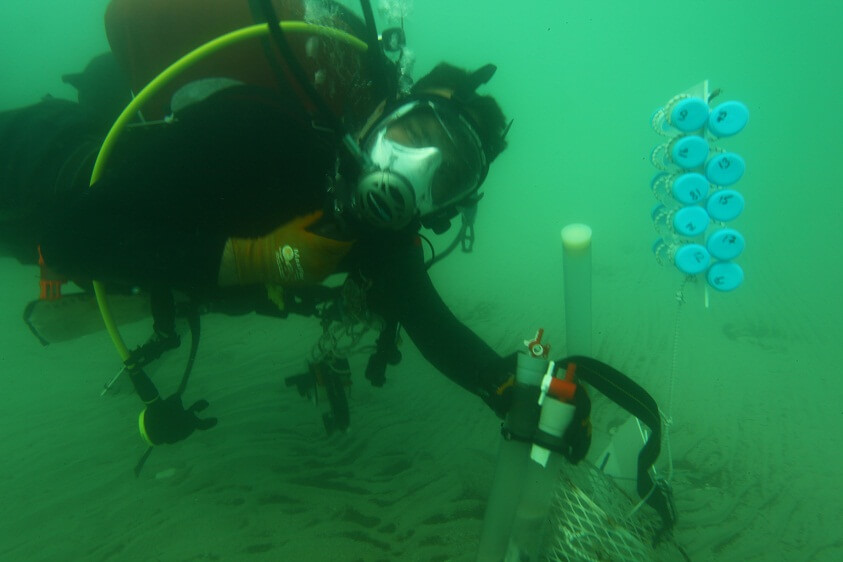A study carried out by the researcher Yaniv Monbaz, under the guidance of Prof. Yonatan Laron from the Department of Geography and Environmental Development at Ben-Gurion University, revealed complex spring systems that extend hundreds of meters along the coast and at a depth of up to 30 meters below the surface of the water

Research carried out by researcher Yaniv Monbaz, under the direction of Prof. Yonatan Leron from the Department of Geography and Environmental Development at Ben-Gurion University, revealed complex spring systems that extend hundreds of meters along the coast and at a depth of up to 30 meters below the surface of the water.
The springs, spectacular in their beauty, erupt from the bottom of the lake through cone-shaped mouths with a diameter of up to 10 meters and a depth of up to 13 meters. In some cases, the researchers observed a system of craters and caves that extend to a depth where the bottom of the Dead Sea is not sandy, but covered with a thick layer of salt. Also, the researchers developed a method for direct measurement of fresh water springs emanating from the bottom of the Dead Sea. The inclusion of divers in the research was an important element in sampling water from the source of the spring to calculate the flow rate, in understanding the structure of the flow and the nature of the source of the spring. The morphology of the underwater springs was also studied with the help of underwater photographs.
"The Dead Sea" explains Prof. Laron "is disappearing but at the same time continues to surprise." For several years, Israeli and German scientists have been researching fresh water springs that arise from the bottom of the Dead Sea. The existence of these springs has been known for a long time and those close to the shore are clearly visible on the surface of the water. Of all the sources of water entering the Dead Sea, there is a particular difficulty in assessing the contribution of the underwater groundwater, some of which originates underwater, hence the importance of our research and discovery."
In a study by Dr. Christian Seibert and Prof. Stephan Geyer from the Helmholtz Institute for Environmental Research in Halle, Germany, the hydrological relationship between underwater springs and coastal springs was investigated. The water samples from the underwater springs and water samples from coastal springs and boreholes show that the system is complex.
It should be noted that already in the thirties of the 20th century, scientists from the Hebrew University realized that the nickname Dead Sea is inappropriate for the Dead Sea and that there are microorganisms that are able to survive.
Prof. Laron: "No one expected the wealth found in the springs area. This does not mean that there is no place to fish in the Dead Sea, but the bacterial mats cover large areas and the species richness is great. The research, led by Dr. Danny Ionesco from the Max Planck Institute for Marine Microbiology in Bremen, showed that many of the microorganisms found are not known to science from other super-saline environments or from other environments at all. These are not the same bacteria and algae that paint the Dead Sea red in rainy winters as happened in 1992. This discovery opens the door to new questions. Part of it relates to the ability of these bacteria to survive in the Dead Sea, and part of it relates to the ability of these creatures to survive in the Dead Sea, where a layer of water is less salty on the surface as will be created if the sea canal plan is implemented."
1. The researchers Prof. Yonatan Laron and Viniv Monbez
2. The team of researchers in action in the Dead Sea.
Photo: PR.

4 תגובות
The video link is not working. Very interesting to see…
Thanks for the explanation.
There is no connection between the salt water and the fresh water except for the fact that the fresh water flows into the Dead Sea. Springs do not have to be visible in order for water to be drawn from them: in the Kinneret, for example, there are a series of salty springs that spring from the depths of the lake and are captured and flowed into the Jordan. At least that was the case in the past, today the route may have changed or because of the shallowness of the Kinneret they stopped pumping from the salty springs. For those who manage to get to the YMCA beach, it is recommended to enter the water and discover a hot spring (yes, yes - the water there is warm). To speak means a lot in terms of the ecosystems that live in the immediate environment. The local animals have adapted and even depend on these unique systems.
Just yesterday a great article was published in ISME about a 2000 km salt gradient and its effect on microorganisms. There too, as in our Dead Sea, the microenvironment and the gradients it creates are of great importance.
It is very gratifying to hear about the fruitful cooperation between Israel and Germany and in particular the combination of Israeli researchers who are at the famous Max Planck Institute. Great fun to read and learn. Good luck in the future to Danny Ionesco and everyone else concerned.
Greetings friends,
Ami Bachar
If the sea is disappearing, will a day come when the springs will be visible or will they actually disappear with the sea itself?
Does the mere existence of the salt water cause, in some way, the emergence of the fresh water or is there no connection between the two?